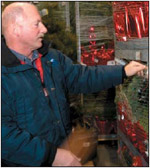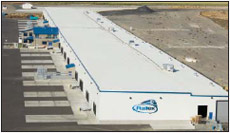Since its first train left Walla Walla County
in mid-2006, Railex’s weekly non-stop service
between Burbank and Rotterdam, N.Y. has
been a shipping success.
In little more than a year,
the innovative company
has grown its original
55-car trains weekly to as
many as 65 and 70 during
peak weeks.
“We were 85-percent
full this past year,” says
Jim Kleist, Railex general
manager for Washington.
“If we continue growing
the way we want to, we’ll
be sending a second train
by the first of 2008.”
Already, Railex has
created full- and part-time
employment for more
than 70 people and added
job opportunities are
expected as the company expands its service.
Kleist said the variety of commodities loaded at Burbank has expanded from potatoes,
onions and apples to include oranges, pears,
wine, a variety of vegetables and nursery stock. |
As many as 200 trucks
from Washington, Oregon,
Idaho, California and
Canada visit the Railex
complex each week to
transfer their loads to
the gigantic temperature controlled
warehouse
where the products await
their five-day trip in
refrigerated rail cars.
While original plans
suggested that the “return
trains” would be empty,
Kleist says an increasing
number of the cars are
coming back to Burbank
filled with items destined
for West Coast markets.
Fruit juices, beer, frozen
foods and import products are among them.

Railex Washington Manager Jim Kleist
says Railex’s biggest “surprise” has
been shipments of fresh nursery stock
from Oregon’s Willamette Valley to New
York. This pallet of fresh Holiday greens
is ready to go. Photo by Donna Lasater
|
Looking to a future that could see three orfour Railex trains out of Burbank each week,
Kleist explains that growth will depend on the
firm’s readiness to meet the demands of the
market.
“We’ve already overcome a huge learning
curve,” Kleist explains. “Compared to a year
ago, we understand a lot more about what’s
being shipped and designing loads to increase
capacity and efficiency.”
The $58-million Railex project, funded by
a private-public partnership that included the
Port of Walla Walla, was in 2006 selected by
Washington Governor Chris Gregoire for
the Governor’s Award for Best Practices in
Economic Development.

Railex Burbank shipping center.
|